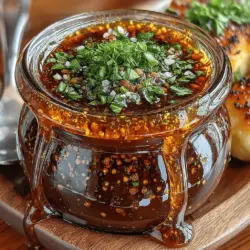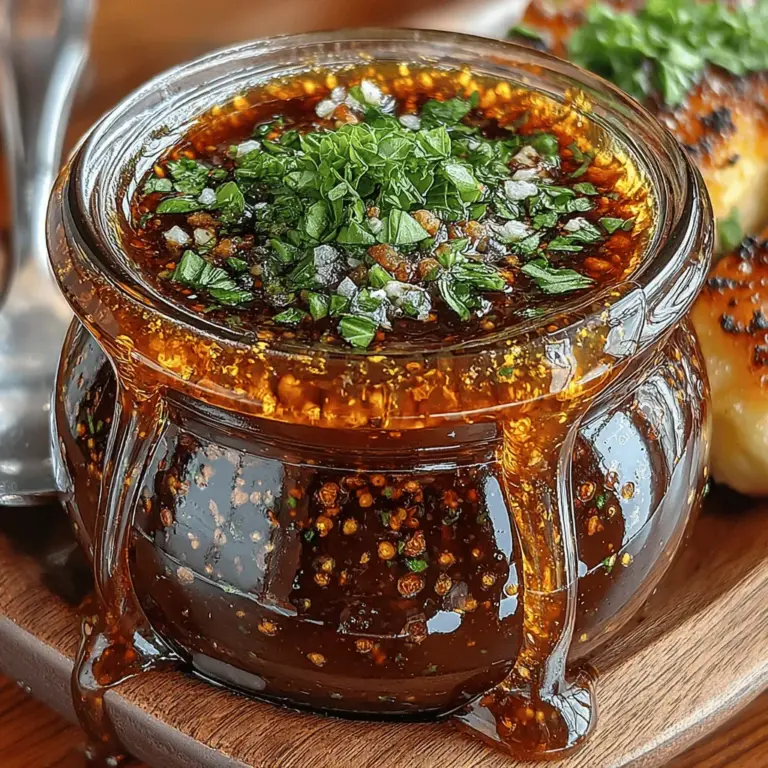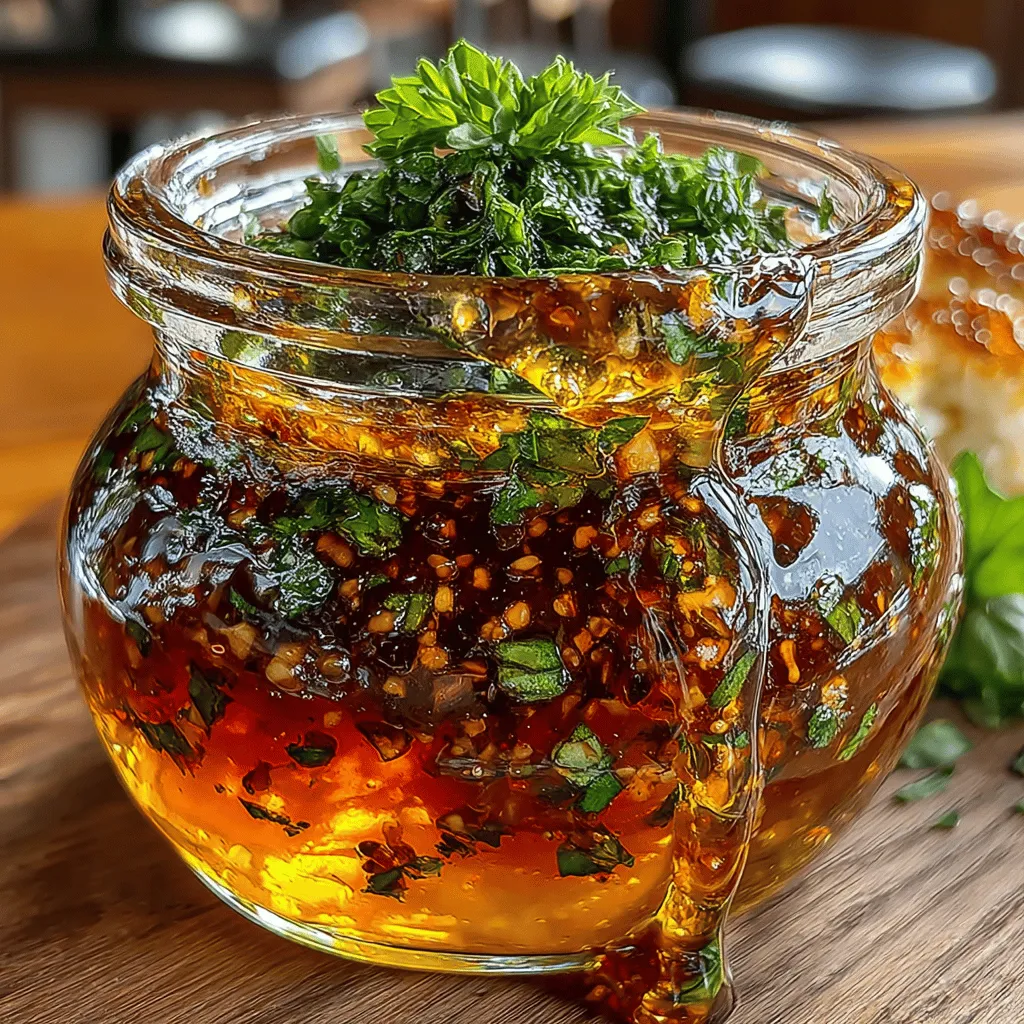Savory-Sweet Balsamic Vinaigrette: A Culinary Essential
Vinaigrettes have long been a staple in kitchens around the world, prized for their ability to elevate a variety of dishes with just a drizzle. Whether dressing a fresh salad, marinating grilled vegetables, or enhancing roasted meats, vinaigrettes offer a delightful balance of flavors that can transform even the simplest of meals. Among the myriad of vinaigrettes available, the Savory-Sweet Balsamic Vinaigrette stands out for its harmonious blend of tangy, sweet, and savory notes. This recipe not only highlights the versatility of balsamic vinegar but also underscores the ease of preparation that makes it a favorite among home cooks.
A Flavorful Balance
The Savory-Sweet Balsamic Vinaigrette is celebrated for its unique ability to balance sweetness with acidity, making it a perfect accompaniment to a wide array of dishes. The robust flavor of balsamic vinegar pairs beautifully with the natural sweetness of honey or maple syrup, while the inclusion of garlic and herbs adds depth and complexity. This vinaigrette is not just a dressing; it’s an experience that enhances the flavor profile of salads, grilled meats, roasted vegetables, and even pasta dishes.
One of the primary advantages of making your own vinaigrette is the opportunity to use fresh, high-quality ingredients. Store-bought dressings often contain preservatives, artificial flavors, and high levels of sugar or sodium. By preparing your own Savory-Sweet Balsamic Vinaigrette, you can ensure a healthier option that not only tastes better but is also free from unwanted additives. Plus, the satisfaction of creating a homemade dressing is an added bonus that enhances the joy of cooking.
Understanding Balsamic Vinaigrette
Before diving into the recipe, it’s essential to understand what balsamic vinaigrette is and its significance in culinary traditions, particularly within Italian cuisine. Balsamic vinegar originates from Modena, Italy, where it has been crafted for centuries using a meticulous process involving the reduction of grape must. This results in a thick, syrupy, and complex vinegar that boasts a rich flavor profile characterized by sweet, tangy, and slightly fruity notes.
The flavor of balsamic vinegar is versatile, making it an ideal addition to a variety of dishes. Its sweetness can complement bitter greens in salads, while its acidity can cut through the richness of fatty meats and cheeses. This adaptability is what has made balsamic vinaigrette a beloved choice for chefs and home cooks alike.
When exploring balsamic vinegar, it’s important to note that there are various types available in the market. Traditional balsamic vinegar is aged for several years, resulting in a deep flavor and thick consistency. On the other hand, commercial varieties tend to be less expensive and may not have the same depth of flavor but can still be excellent for vinaigrettes. Understanding these differences will empower you to choose the right balsamic vinegar for your Savory-Sweet Balsamic Vinaigrette.
Ingredients Breakdown
Crafting the perfect Savory-Sweet Balsamic Vinaigrette involves selecting quality ingredients that contribute to its signature flavor. Here’s a closer look at each component:
1. Balsamic Vinegar: The star of the show, balsamic vinegar provides the foundational flavor. When selecting balsamic vinegar, opt for high-quality varieties that have been aged. The aging process enhances the complexity and sweetness, making it a superior choice for dressings.
2. Extra Virgin Olive Oil: This oil is preferred for vinaigrettes due to its rich flavor and health benefits. Extra virgin olive oil is packed with antioxidants and healthy fats, making it a heart-healthy choice. Its robust flavor complements the tanginess of balsamic vinegar perfectly.
3. Honey vs. Maple Syrup: Sweeteners play a crucial role in balancing the acidity of the vinegar. Honey adds a floral sweetness, while maple syrup offers a more earthy flavor. For those following a vegan diet, maple syrup is the ideal substitute.
4. Dijon Mustard: This ingredient serves two purposes: it enhances the flavor of the vinaigrette and acts as an emulsifier, helping to blend the oil and vinegar into a cohesive dressing.
5. Garlic: Garlic adds a savory depth to the vinaigrette. It not only infuses the dressing with flavor but also offers numerous health benefits, including anti-inflammatory properties.
6. Dried Oregano: An aromatic herb, dried oregano contributes a subtle earthiness that complements the other flavors in the vinaigrette. It’s a common herb in Mediterranean cuisine, further tying the dressing to its Italian roots.
7. Salt and Black Pepper: Seasoning is key in any recipe. A pinch of salt enhances the flavors, while freshly cracked black pepper adds a bit of heat and complexity.
8. Fresh Herbs: While optional, adding fresh herbs such as basil, thyme, or parsley can elevate the vinaigrette’s flavor and presentation. Fresh herbs bring brightness and a pop of color that can make your dish visually appealing.
Step-by-Step Instructions for Making Balsamic Vinaigrette
Now that you have a comprehensive understanding of the ingredients, it’s time to dive into the preparation of the Savory-Sweet Balsamic Vinaigrette. Follow these simple steps to create a dressing that’s sure to impress:
1. Gather Your Ingredients: Start by assembling all your ingredients on a clean countertop. This includes balsamic vinegar, extra virgin olive oil, honey or maple syrup, Dijon mustard, minced garlic, dried oregano, salt, and black pepper.
2. Combine the Ingredients: In a mixing bowl or a mason jar, combine the balsamic vinegar, honey (or maple syrup), Dijon mustard, minced garlic, and dried oregano. Whisk or shake until the mixture is well combined.
3. Emulsify the Dressing: While whisking or shaking vigorously, slowly drizzle in the extra virgin olive oil. This process helps to emulsify the oil and vinegar, creating a smooth and cohesive vinaigrette.
4. Season to Taste: Once the oil is fully incorporated, taste the vinaigrette and season with salt and black pepper as desired. Adjust the sweetness or acidity by adding more honey or vinegar, depending on your preference.
5. Add Fresh Herbs (Optional): If you’d like to incorporate fresh herbs, finely chop them and stir them into the vinaigrette for added flavor and visual appeal.
6. Serve or Store: Your Savory-Sweet Balsamic Vinaigrette is now ready to use! Drizzle it over your favorite salads, grilled vegetables, or roasted meats. If you have any leftovers, store the vinaigrette in an airtight container in the refrigerator for up to one week. Be sure to shake well before using, as the ingredients may separate over time.
By following these steps, you’ll have a delightful Savory-Sweet Balsamic Vinaigrette that enhances your meals and showcases the incredible flavors of fresh ingredients. This dressing not only serves as a delicious addition to your culinary repertoire but also embodies a healthier alternative to store-bought options, making it a must-try for any home cook.
Combining the Ingredients
Creating the perfect Savory-Sweet Balsamic Vinaigrette begins with proper mixing and blending techniques. Start with a small mixing bowl where you can control the ingredients more easily. Begin by adding the balsamic vinegar, honey, Dijon mustard, and minced garlic. These ingredients form the core of your vinaigrette, delivering a balance of acidity, sweetness, and depth.
To enhance the flavor of your vinaigrette, consider adding a pinch of salt and freshly cracked black pepper at this stage. These seasonings not only enhance the overall taste but also help to elevate the other ingredients. Using a whisk or a fork, mix these ingredients together until they are well combined and the honey is fully dissolved.
Emulsification Process
The emulsification process is crucial for achieving a creamy, cohesive vinaigrette. This is where the magic happens—transforming your simple mixture into a rich dressing that clings beautifully to your salads.
To properly emulsify your vinaigrette, gradually drizzle the olive oil into the vinegar mixture while continuously whisking. This slow incorporation allows the oil and vinegar to blend seamlessly, creating a stable emulsion. If you add the oil too quickly, the mixture may separate, leading to a less desirable texture. Aim for a steady stream of olive oil, whisking vigorously until the vinaigrette thickens slightly and appears glossy. The result should be a beautifully emulsified dressing that is both flavorful and visually appealing.
Tasting and Adjusting
One of the best parts of making homemade vinaigrette is the ability to tailor it to your personal tastes. After emulsifying your vinaigrette, take a moment to taste it. The flavor balance may need adjustments based on your preference. If you find the vinaigrette too tangy, add a touch more honey to sweeten it up. Conversely, if you desire more acidity, a splash of additional balsamic vinegar may do the trick.
Remember that flavors can evolve over time, so don’t hesitate to make small adjustments until you achieve the perfect balance. This personalization is what makes homemade vinaigrettes so enjoyable; they can be customized to suit different occasions, dishes, and even guests.
Garnishing
A well-garnished vinaigrette can elevate the overall dining experience, making it more visually appealing and flavorful. Fresh herbs play a significant role in this aspect. Consider adding chopped fresh basil, parsley, or chives to your vinaigrette. Not only do these herbs enhance the visual appeal with their vibrant colors, but they also impart fresh, aromatic flavors that complement the balsamic and honey beautifully.
To incorporate herbs, mix them in just before serving or use them as a garnish on top of your salad drizzled with vinaigrette. This small touch can significantly enhance the flavor profile of your dish, making it more inviting and delicious.
Storage and Longevity
Storing your homemade Savory-Sweet Balsamic Vinaigrette correctly ensures that it remains fresh and flavorful for as long as possible. Transfer the vinaigrette into a clean, airtight container, ideally a glass jar with a tight-fitting lid. This will help prevent any contamination and extend its shelf life.
Best Practices for Storing Homemade Vinaigrette
Homemade vinaigrettes can typically be stored in the refrigerator for up to two weeks. However, it’s essential to check for any signs of spoilage before using it. If you notice any off odors, unusual colors, or a change in texture, it’s best to discard the vinaigrette.
Importance of Shaking Before Use
Due to the natural separation of oil and vinegar, it’s crucial to shake your vinaigrette well before each use. This will re-emulsify the dressing, ensuring that every pour is as flavorful as the first. If you find that your vinaigrette has thickened too much in the fridge, you can also add a teaspoon of water and shake it again to achieve your desired consistency.
Culinary Uses for Savory-Sweet Balsamic Vinaigrette
The versatility of Savory-Sweet Balsamic Vinaigrette makes it an essential addition to any kitchen. Not only does it serve as a delightful salad dressing, but it can also elevate a variety of dishes.
Pairing Suggestions
This vinaigrette pairs wonderfully with a wide range of salads. Consider using it on mixed greens, spinach, or arugula, where it can add a delightful tang. You can also enhance salads featuring roasted vegetables, nuts, or fruits like strawberries or pears, which complement the vinaigrette’s sweet notes.
Use as a Marinade
Beyond salads, this vinaigrette works exceptionally well as a marinade for meats and vegetables. Simply coat your protein of choice, such as chicken, pork, or tofu, in the vinaigrette and let it marinate for at least 30 minutes before cooking. This will infuse the ingredients with flavor and help keep them moist during cooking.
Drizzling Over Roasted Dishes
Another culinary application is drizzling the vinaigrette over roasted vegetables or grains. Once your vegetables have caramelized and developed a rich flavor, a splash of this vinaigrette can enhance their taste, adding a layer of complexity. Similarly, pouring it over a bowl of quinoa or farro can elevate your grain dishes, transforming them into something spectacular.
Incorporating into Grain Bowls
Savory-Sweet Balsamic Vinaigrette is also a fantastic addition to grain bowls. Combining grains with fresh vegetables, proteins, and a drizzle of this vinaigrette creates a balanced meal that is both nutritious and satisfying. It acts as a cohesive element, tying together the various ingredients while adding depth of flavor.
Dipping Sauce for Appetizers
Finally, consider using this vinaigrette as a dipping sauce for appetizers. Whether you’re serving fresh bread, vegetable crudités, or cheese platters, a small bowl of vinaigrette can provide a refreshing contrast that encourages guests to enjoy the spread.
Nutritional Benefits of Homemade Vinaigrette
When comparing homemade vinaigrettes to store-bought options, the nutritional benefits of making your own become clear. Store-bought dressings often contain preservatives, artificial flavors, and excessive sugars. In contrast, your homemade Savory-Sweet Balsamic Vinaigrette features wholesome, natural ingredients that you control.
Nutritional Value of Ingredients
Balsamic vinegar is rich in antioxidants and can support heart health, while olive oil is an excellent source of healthy fats, particularly monounsaturated fats, which are beneficial for maintaining a balanced diet. Honey, when used in moderation, adds natural sweetness and can provide antioxidants as well.
By opting for homemade vinaigrette, you not only avoid the unnecessary additives found in commercial dressings, but you also ensure that your meals are packed with flavor and nutrition.
The Role of Healthy Fats in a Balanced Diet
Healthy fats, like those found in olive oil, are essential for various bodily functions, including nutrient absorption and hormone regulation. Incorporating a moderate amount of healthy fats into your diet can promote overall health, making this vinaigrette an excellent choice for enhancing your meals.
Conclusion
In summary, the Savory-Sweet Balsamic Vinaigrette is a simple yet versatile addition to any culinary repertoire. The process of creating this dressing—from combining ingredients to emulsification—allows for personalization that can cater to individual tastes. With its ability to elevate salads, act as a marinade, and enhance a variety of dishes, this vinaigrette stands out as a must-have in your kitchen.
Exploring homemade dressings not only enriches your meals but also gives you control over the ingredients you consume. Embrace the joy of cooking and the satisfaction of creating flavorful, healthy dishes at home. Your culinary journey begins with simple recipes like this vinaigrette, inviting you to experiment and enjoy the art of homemade cooking.


